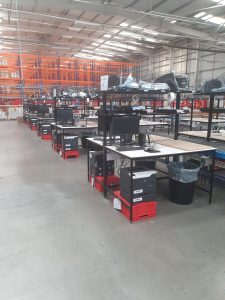Your basket is currently empty!

How to manage approaching 100% warehouse storage capacity
09/09/2024 by Katrina
If the storage capacity of a warehouse nears 100%, inefficiencies are, unfortunately, more likely to increase. Replenishing stock is difficult if it is unable to be stored in the optimal location within easy reach of aisle picking trolleys.
The only places to store new inventory could be in more difficult to access places. There are several ways to tackle this issue without the need to relocate to a larger warehouse.
Stock levels can be reduced, though it is challenging to manage minimal levels in ways that avoid out of stock items. For many warehouses it’s easier to optimise storage methods. Start by making a drawing of the existing warehouse layout to analyse where improvements can be made. Calculate the percentage of space allocated for stock storage. Can this be increased by reducing other areas such as those used for administration or packing stations? Some warehouses have replaced the warehouse space occupied by staff break facilities by using portable cabin units outside the main warehouse.
Storage racks can often be reconfigured to better suit the size of stock by reducing the empty space above items. Aisle widths can be reduced to allow for extra storage racks, as long as this does not restrict the speed of personnel and equipment. A warehouse storage racks supplier may have storage equipment that is better suited to the profile of goods stored.
For some warehouses, offsite storage may be the solution by either renting space in other warehouses or using fulfilment companies to handle some orders.
You may also interested in:

Warehouse operators warned about energy compliance crisis
New energy regulations could render some warehouse space unusable by 2030 due to
The growing demand for warehouse conveyor belts
Research by Global Market Insights shows that the worldwide conveyor market was worth 5.7 billion US dollars in 2024 and is
